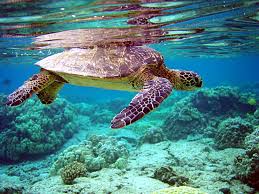 The Mary River turtle is making big splashes outside the waters of its native Australia. The turtle is an attention-grabbing entry on a newly published list of reptiles at risk of extinction. Some observers love the turtle’s green “hair.” Of course, reptiles don’t have hair anywhere on their bodies, but a distinctive-looking Mary River turtle was caught on film with strands of algae growing from its head. Underwater, the strands stood on end, giving the turtle a punk-rock appearance.
The Mary River turtle is making big splashes outside the waters of its native Australia. The turtle is an attention-grabbing entry on a newly published list of reptiles at risk of extinction. Some observers love the turtle’s green “hair.” Of course, reptiles don’t have hair anywhere on their bodies, but a distinctive-looking Mary River turtle was caught on film with strands of algae growing from its head. Underwater, the strands stood on end, giving the turtle a punk-rock appearance.
Scientists aren’t captivated by the turtle’s look. Instead, researchers are interested in the Mary River turtle’s ability to breathe through its cloaca. The cloaca is a common anatomical feature found in many animals, including birds, amphibians and reptiles. It serves as an exit point for the digestive, urinary and reproductive tracts. In most animals, it’s not connected to the respiratory system in any way, but the Mary River turtle can use its cloaca to draw oxygen from water. This allows the turtle to stay below the water’s surface for as long as 72 hours, according to The New York Times.
Other animals on the list aren’t as flashy, but they all have the potential to advance human understanding of the natural world. The most at-risk reptile is the Madagascar big-headed turtle, a weird specimen whose closest relatives are long-extinct dinosaurs. Second place goes to the Central American river turtle, which is also linked back millions of years to dinosaur relatives. Third on the list is the Madagascar blind snake, an important animal for understanding evolutionary biology and geology. There are almost no fossils of blind snakes, so scientists must study living populations to learn about genetic drift.
While the Mary River turtle is only in thirtieth place on the at-risk list, its unique traits make it the perfect poster child for the campaign to raise awareness of the risks faced by reptile species. Wildlife conservation campaigns are usually dominated by cute and cuddly creatures like panda bears and baby elephants. Hopefully the attention-grabbing nature of this green-haired, genital-breathing turtle will help the public focus more on the importance of preserving reptiles.








